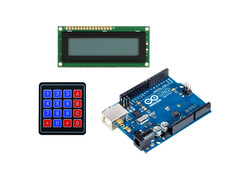Arduino Projects and Hacks
-
Arduino Uno Calculator: How to Create your DIY Calculator
One of the most basic but formative projects with Arduino Uno is performing algebraic calculus with a custom-designed calculator by using a 4×4 keypad, Arduino
-
Mole crab robot burrows into sand using flexible legs | Arduino Blog
Revolutionary new technologies tend to require small, incremental developments. For example, physicist Julius Edgar Lilienfeld filed a patent for a transistor way back in 1925. But it wasn’t possible to actually build transistors until semiconductor production caught up in 1947 — something that took decades of “boring” materials research. Such research may seem trivial, but often turns out to be important to the bigger picture. That is likely the case with this burrowing mole crab robot, called EMBUR, built by UC Berkeley engineers.
This Arduino Due-controlled robot can burrow into loose substrates like a mole crab in sand. In the wild, mole crabs can bury their bodies in sand within a few seconds. That is surprisingly hard to replicate, as wriggling robots tend to just push themselves up on top of the sand. The key to this robot’s burrowing ability is a special set of flexible legs. The Arduino spins motors that rotate a reciprocating mechanism to actuate legs covered in fabric. When the legs push forward into the substrate, the fabric folds to decrease resistance. Then when the legs move back, the fabric unfurls and creates resistance for propulsion.
-
The Great Resistor lamp makes color codes readable | Arduino Blog
Resistor color codes are great, because they make it easy to identify a resistor’s value by referencing a simple chart (or memorizing that chart). But resistors are also very small and their color bands are hard for many of us to see clearly. Instead of buying a magnifying glass, J built the Great Resistor lamp that reproduces a resistor’s color code at a much larger scale.
To display a resistor’s value, one must first find that value. To measure the resistance of unknown resistors, J used an Arduino Nano and a 16-bit ADC (analog-to-digital converter) to measure the input and output voltages of a voltage divider circuit. One of the resistors in that circuit has a known value, while the second is the unknown resistor being tested. The three known values let the Arduino calculate the unknown value, which is the resistance of the tested resistor.

